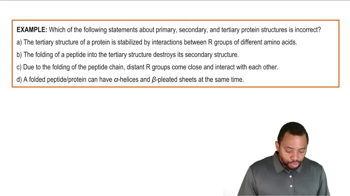How many ways can four different amino acids be arranged in a peptide so that each peptide is unique?
Both α-keratin and tropocollagen have helical secondary structure. How do these molecules differ in (a) amino acid composition and (b) three-dimensional structure?
 Verified step by step guidance
Verified step by step guidance
Verified Solution
Key Concepts
α-Keratin
Tropocollagen
Secondary and Tertiary Structure

Examine the α-helix in Figure 18.1 and determine how many backbone C and N atoms are included in the loop between an amide hydrogen atom and the carbonyl oxygen to which it is hydrogen bonded.
Consult the β-sheet in Figure 18.2 and (a) name the bonding responsible for the sheet formation and (b) identify the specific atoms responsible for this bonding.
Draw the hexapeptide Asp-Gly-Phe-Leu-Glu-Ala in linear form showing all of the atoms, and show (using dotted lines) the hydrogen bonding that stabilizes this structure if it is part of an α-helix.
Compare and contrast the characteristics of fibrous and globular proteins. Consider biological function, water solubility, amino acid composition, secondary structure, and tertiary structure. Give examples of three fibrous and three globular proteins. (Hint: Make a table.)
Cell membranes are studded with proteins. Some of these proteins, involved in the transport of molecules across the membrane into the cell, span the entire membrane and are called transmembrane proteins. The interior of the cell membrane is hydrophobic and nonpolar, whereas both the extracellular and intracellular fluids are water-based.
a. List three amino acids you would expect to find in the part of a transmembrane protein that lies within the cell membrane.
